ACC201 Financial Accounting Report: Intangible Assets and Provisions
VerifiedAdded on 2022/10/02
|7
|1354
|293
Report
AI Summary
This report delves into key financial accounting topics, focusing on intangible assets, goodwill, and restructuring provisions, referencing relevant AASB standards. The report begins by examining AASB 138, detailing the recognition and measurement of intangible assets, including brand valuation and the treatment of internally generated brands. It then moves on to AASB 136, discussing the recognition of goodwill, its impairment, and the implications of changes in its useful life. The analysis extends to a case study, evaluating investment decisions based on goodwill and brand value. Finally, the report explores AASB 137, addressing accounting for restructuring provisions, including the criteria for recognition, events that constitute restructuring, and disclosure requirements. The report includes practical applications and examples to illustrate the concepts, providing a comprehensive overview of financial accounting principles related to these crucial areas.
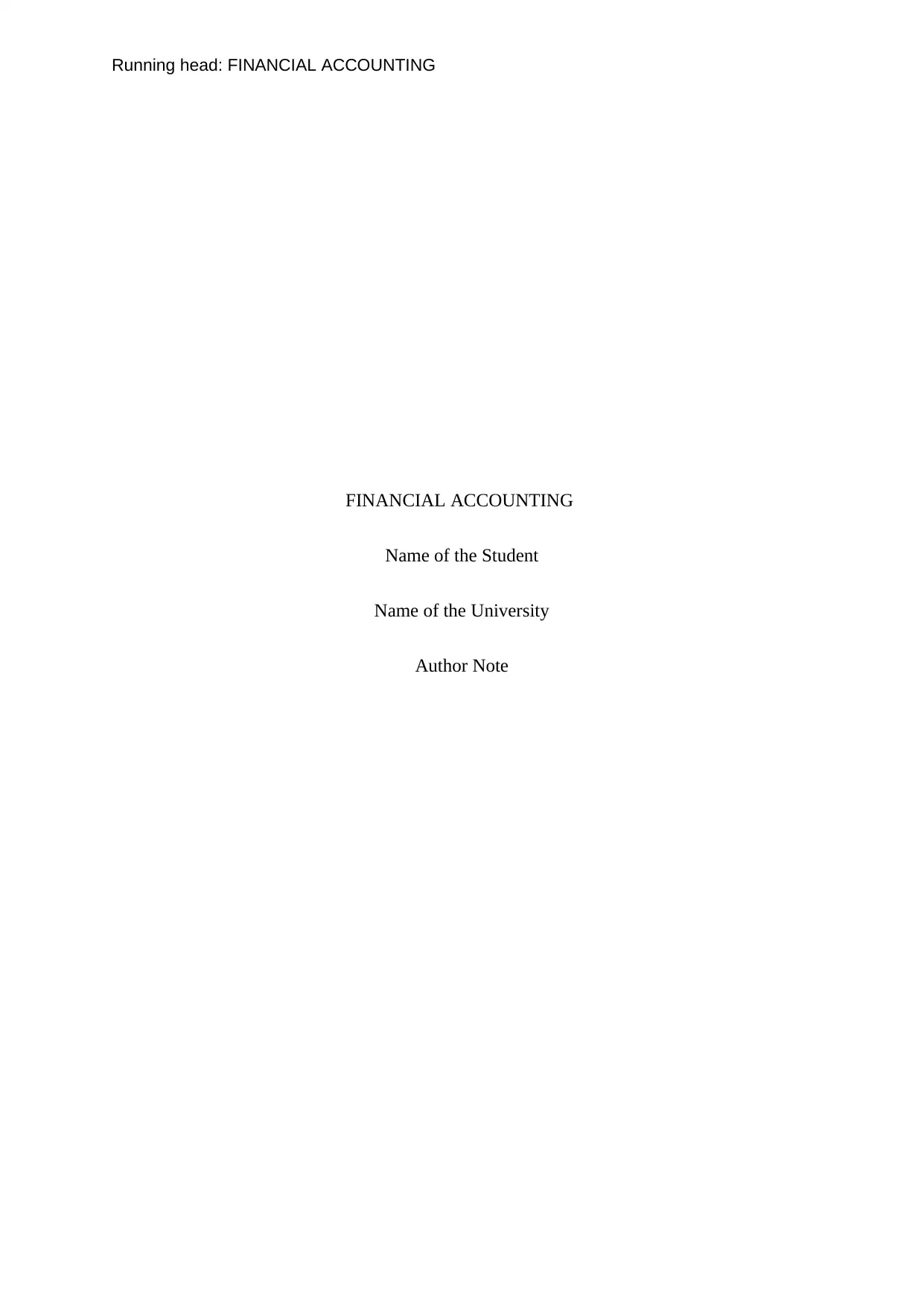
Running head: FINANCIAL ACCOUNTING
FINANCIAL ACCOUNTING
Name of the Student
Name of the University
Author Note
FINANCIAL ACCOUNTING
Name of the Student
Name of the University
Author Note
Paraphrase This Document
Need a fresh take? Get an instant paraphrase of this document with our AI Paraphraser
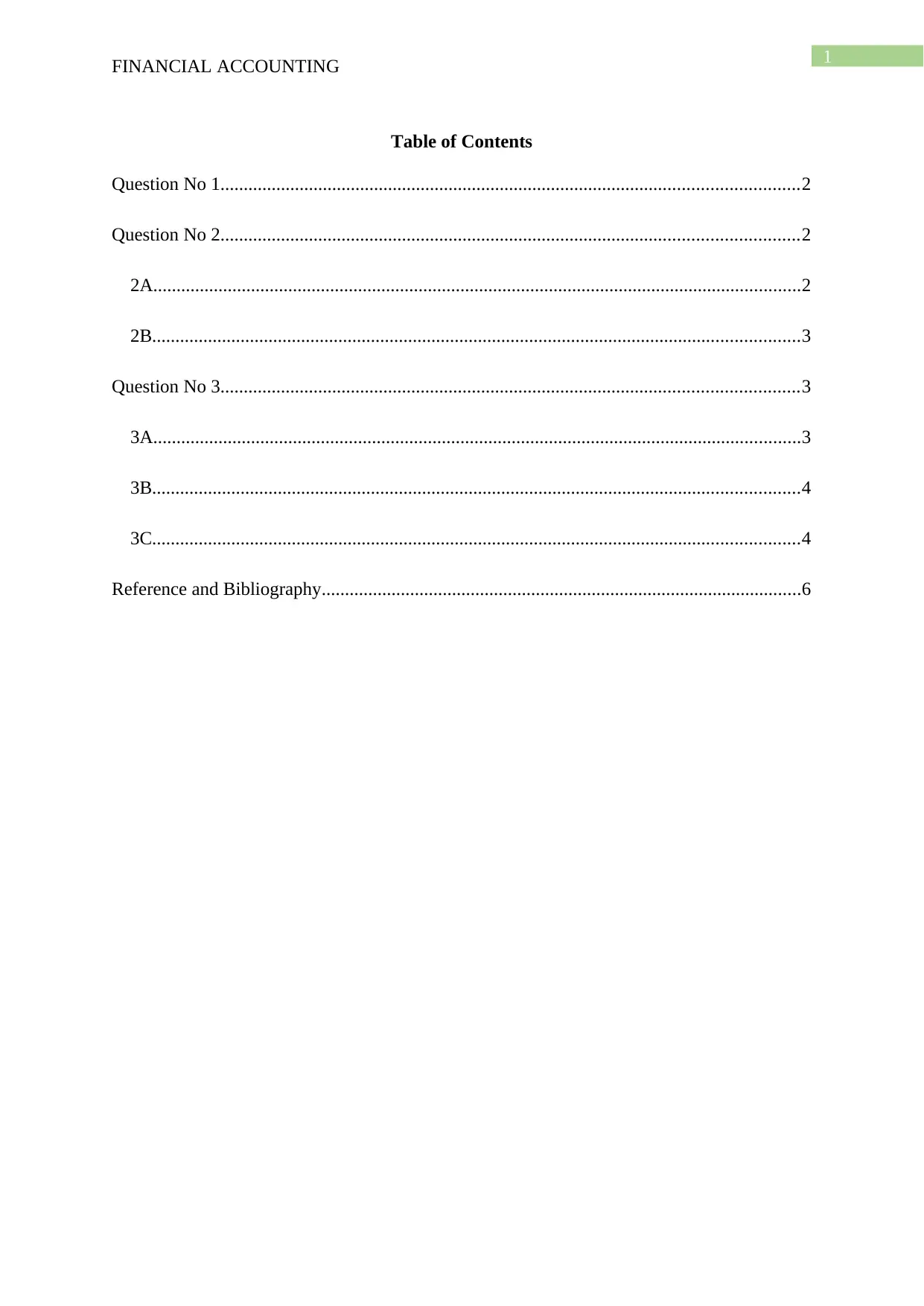
1
FINANCIAL ACCOUNTING
Table of Contents
Question No 1............................................................................................................................2
Question No 2............................................................................................................................2
2A...........................................................................................................................................2
2B...........................................................................................................................................3
Question No 3............................................................................................................................3
3A...........................................................................................................................................3
3B...........................................................................................................................................4
3C...........................................................................................................................................4
Reference and Bibliography.......................................................................................................6
FINANCIAL ACCOUNTING
Table of Contents
Question No 1............................................................................................................................2
Question No 2............................................................................................................................2
2A...........................................................................................................................................2
2B...........................................................................................................................................3
Question No 3............................................................................................................................3
3A...........................................................................................................................................3
3B...........................................................................................................................................4
3C...........................................................................................................................................4
Reference and Bibliography.......................................................................................................6
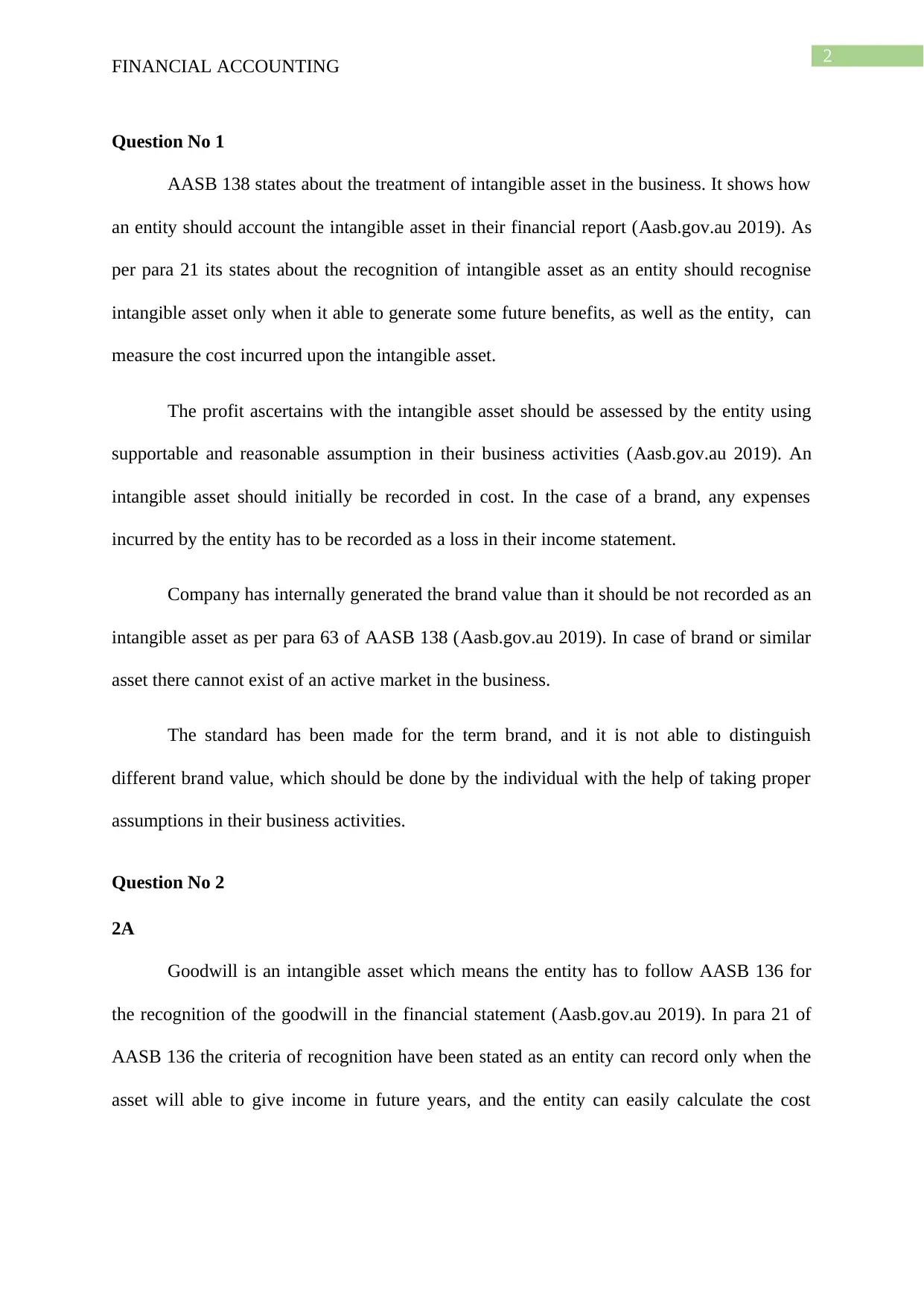
2
FINANCIAL ACCOUNTING
Question No 1
AASB 138 states about the treatment of intangible asset in the business. It shows how
an entity should account the intangible asset in their financial report (Aasb.gov.au 2019). As
per para 21 its states about the recognition of intangible asset as an entity should recognise
intangible asset only when it able to generate some future benefits, as well as the entity, can
measure the cost incurred upon the intangible asset.
The profit ascertains with the intangible asset should be assessed by the entity using
supportable and reasonable assumption in their business activities (Aasb.gov.au 2019). An
intangible asset should initially be recorded in cost. In the case of a brand, any expenses
incurred by the entity has to be recorded as a loss in their income statement.
Company has internally generated the brand value than it should be not recorded as an
intangible asset as per para 63 of AASB 138 (Aasb.gov.au 2019). In case of brand or similar
asset there cannot exist of an active market in the business.
The standard has been made for the term brand, and it is not able to distinguish
different brand value, which should be done by the individual with the help of taking proper
assumptions in their business activities.
Question No 2
2A
Goodwill is an intangible asset which means the entity has to follow AASB 136 for
the recognition of the goodwill in the financial statement (Aasb.gov.au 2019). In para 21 of
AASB 136 the criteria of recognition have been stated as an entity can record only when the
asset will able to give income in future years, and the entity can easily calculate the cost
FINANCIAL ACCOUNTING
Question No 1
AASB 138 states about the treatment of intangible asset in the business. It shows how
an entity should account the intangible asset in their financial report (Aasb.gov.au 2019). As
per para 21 its states about the recognition of intangible asset as an entity should recognise
intangible asset only when it able to generate some future benefits, as well as the entity, can
measure the cost incurred upon the intangible asset.
The profit ascertains with the intangible asset should be assessed by the entity using
supportable and reasonable assumption in their business activities (Aasb.gov.au 2019). An
intangible asset should initially be recorded in cost. In the case of a brand, any expenses
incurred by the entity has to be recorded as a loss in their income statement.
Company has internally generated the brand value than it should be not recorded as an
intangible asset as per para 63 of AASB 138 (Aasb.gov.au 2019). In case of brand or similar
asset there cannot exist of an active market in the business.
The standard has been made for the term brand, and it is not able to distinguish
different brand value, which should be done by the individual with the help of taking proper
assumptions in their business activities.
Question No 2
2A
Goodwill is an intangible asset which means the entity has to follow AASB 136 for
the recognition of the goodwill in the financial statement (Aasb.gov.au 2019). In para 21 of
AASB 136 the criteria of recognition have been stated as an entity can record only when the
asset will able to give income in future years, and the entity can easily calculate the cost
⊘ This is a preview!⊘
Do you want full access?
Subscribe today to unlock all pages.

Trusted by 1+ million students worldwide
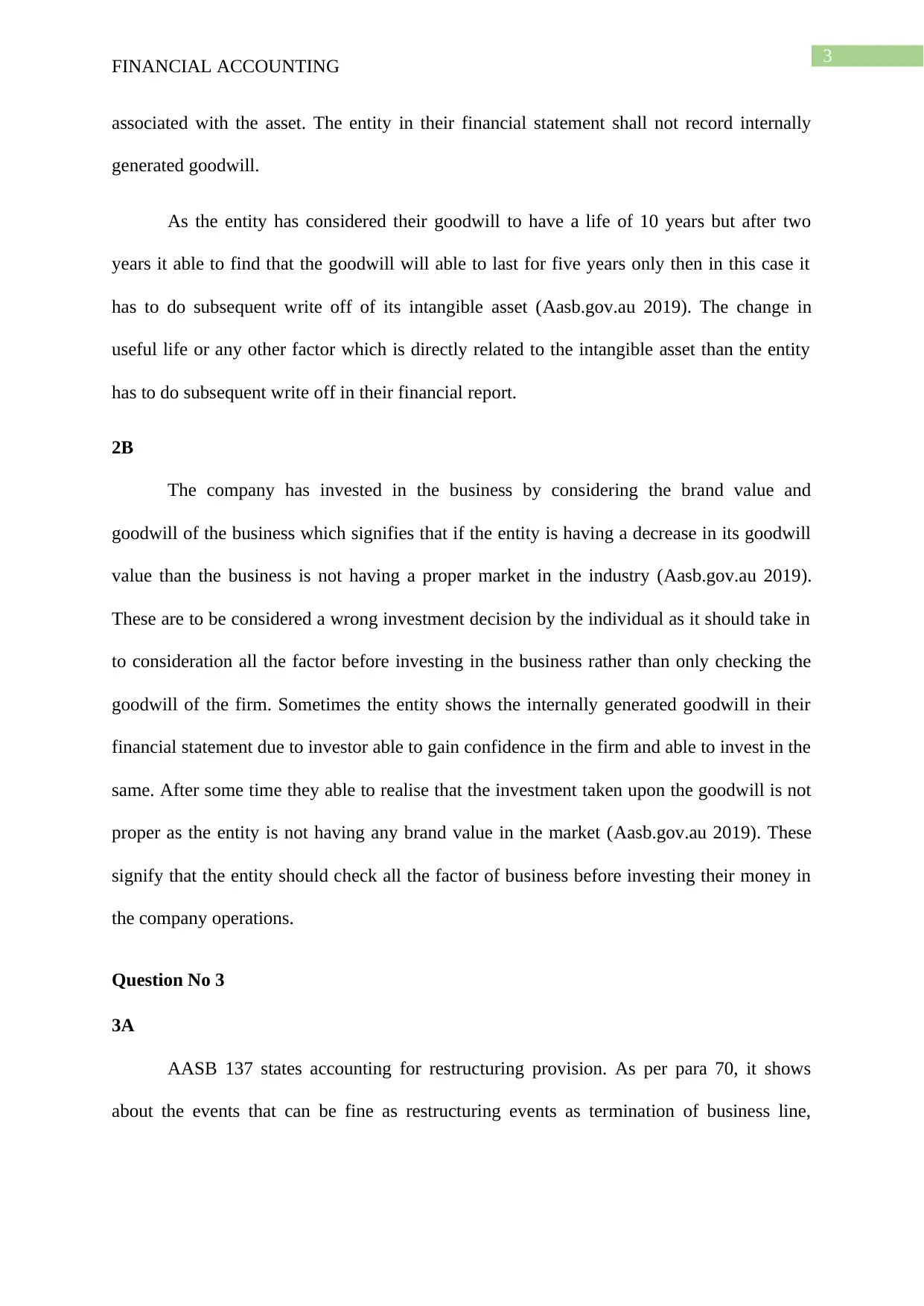
3
FINANCIAL ACCOUNTING
associated with the asset. The entity in their financial statement shall not record internally
generated goodwill.
As the entity has considered their goodwill to have a life of 10 years but after two
years it able to find that the goodwill will able to last for five years only then in this case it
has to do subsequent write off of its intangible asset (Aasb.gov.au 2019). The change in
useful life or any other factor which is directly related to the intangible asset than the entity
has to do subsequent write off in their financial report.
2B
The company has invested in the business by considering the brand value and
goodwill of the business which signifies that if the entity is having a decrease in its goodwill
value than the business is not having a proper market in the industry (Aasb.gov.au 2019).
These are to be considered a wrong investment decision by the individual as it should take in
to consideration all the factor before investing in the business rather than only checking the
goodwill of the firm. Sometimes the entity shows the internally generated goodwill in their
financial statement due to investor able to gain confidence in the firm and able to invest in the
same. After some time they able to realise that the investment taken upon the goodwill is not
proper as the entity is not having any brand value in the market (Aasb.gov.au 2019). These
signify that the entity should check all the factor of business before investing their money in
the company operations.
Question No 3
3A
AASB 137 states accounting for restructuring provision. As per para 70, it shows
about the events that can be fine as restructuring events as termination of business line,
FINANCIAL ACCOUNTING
associated with the asset. The entity in their financial statement shall not record internally
generated goodwill.
As the entity has considered their goodwill to have a life of 10 years but after two
years it able to find that the goodwill will able to last for five years only then in this case it
has to do subsequent write off of its intangible asset (Aasb.gov.au 2019). The change in
useful life or any other factor which is directly related to the intangible asset than the entity
has to do subsequent write off in their financial report.
2B
The company has invested in the business by considering the brand value and
goodwill of the business which signifies that if the entity is having a decrease in its goodwill
value than the business is not having a proper market in the industry (Aasb.gov.au 2019).
These are to be considered a wrong investment decision by the individual as it should take in
to consideration all the factor before investing in the business rather than only checking the
goodwill of the firm. Sometimes the entity shows the internally generated goodwill in their
financial statement due to investor able to gain confidence in the firm and able to invest in the
same. After some time they able to realise that the investment taken upon the goodwill is not
proper as the entity is not having any brand value in the market (Aasb.gov.au 2019). These
signify that the entity should check all the factor of business before investing their money in
the company operations.
Question No 3
3A
AASB 137 states accounting for restructuring provision. As per para 70, it shows
about the events that can be fine as restructuring events as termination of business line,
Paraphrase This Document
Need a fresh take? Get an instant paraphrase of this document with our AI Paraphraser
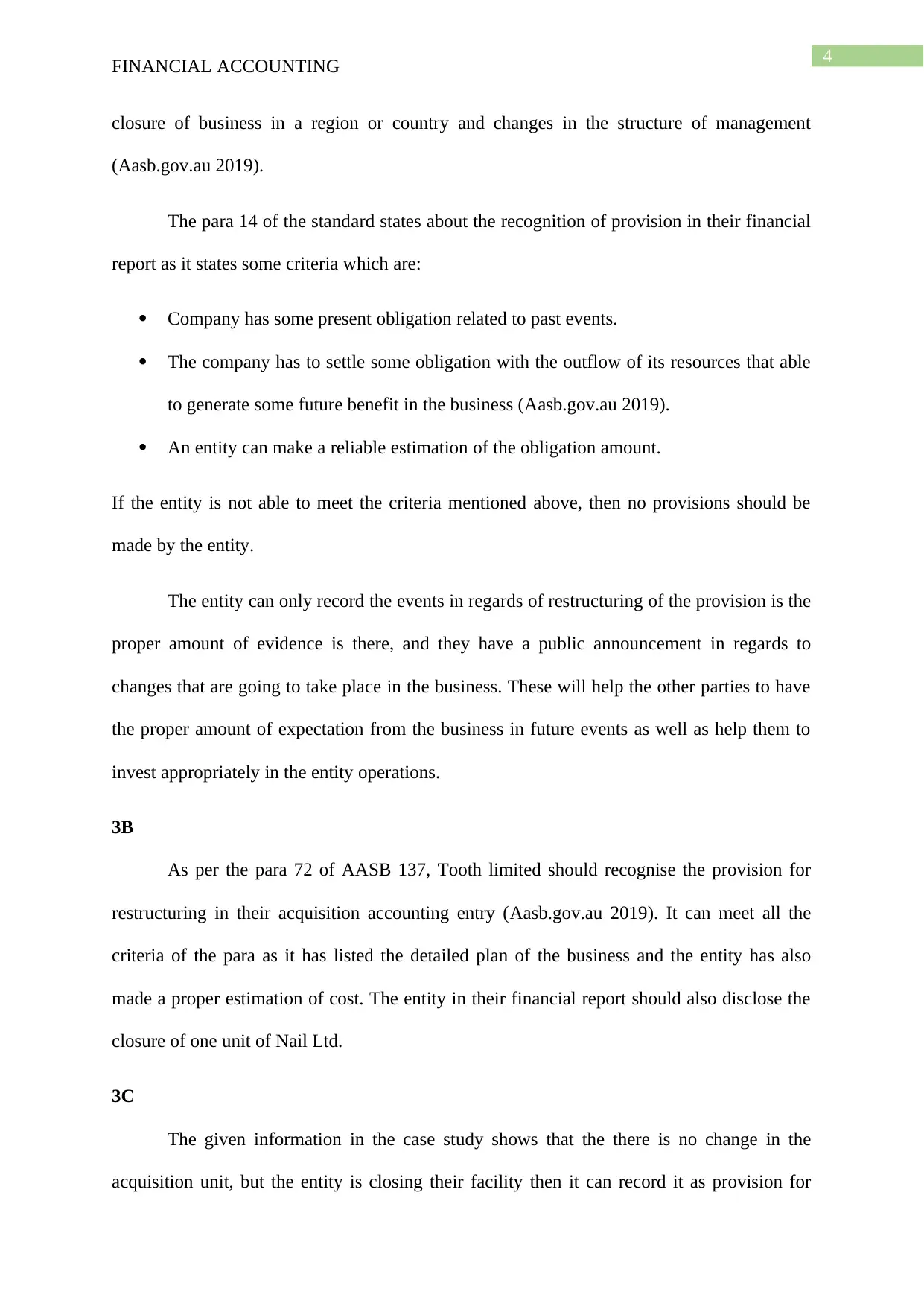
4
FINANCIAL ACCOUNTING
closure of business in a region or country and changes in the structure of management
(Aasb.gov.au 2019).
The para 14 of the standard states about the recognition of provision in their financial
report as it states some criteria which are:
Company has some present obligation related to past events.
The company has to settle some obligation with the outflow of its resources that able
to generate some future benefit in the business (Aasb.gov.au 2019).
An entity can make a reliable estimation of the obligation amount.
If the entity is not able to meet the criteria mentioned above, then no provisions should be
made by the entity.
The entity can only record the events in regards of restructuring of the provision is the
proper amount of evidence is there, and they have a public announcement in regards to
changes that are going to take place in the business. These will help the other parties to have
the proper amount of expectation from the business in future events as well as help them to
invest appropriately in the entity operations.
3B
As per the para 72 of AASB 137, Tooth limited should recognise the provision for
restructuring in their acquisition accounting entry (Aasb.gov.au 2019). It can meet all the
criteria of the para as it has listed the detailed plan of the business and the entity has also
made a proper estimation of cost. The entity in their financial report should also disclose the
closure of one unit of Nail Ltd.
3C
The given information in the case study shows that the there is no change in the
acquisition unit, but the entity is closing their facility then it can record it as provision for
FINANCIAL ACCOUNTING
closure of business in a region or country and changes in the structure of management
(Aasb.gov.au 2019).
The para 14 of the standard states about the recognition of provision in their financial
report as it states some criteria which are:
Company has some present obligation related to past events.
The company has to settle some obligation with the outflow of its resources that able
to generate some future benefit in the business (Aasb.gov.au 2019).
An entity can make a reliable estimation of the obligation amount.
If the entity is not able to meet the criteria mentioned above, then no provisions should be
made by the entity.
The entity can only record the events in regards of restructuring of the provision is the
proper amount of evidence is there, and they have a public announcement in regards to
changes that are going to take place in the business. These will help the other parties to have
the proper amount of expectation from the business in future events as well as help them to
invest appropriately in the entity operations.
3B
As per the para 72 of AASB 137, Tooth limited should recognise the provision for
restructuring in their acquisition accounting entry (Aasb.gov.au 2019). It can meet all the
criteria of the para as it has listed the detailed plan of the business and the entity has also
made a proper estimation of cost. The entity in their financial report should also disclose the
closure of one unit of Nail Ltd.
3C
The given information in the case study shows that the there is no change in the
acquisition unit, but the entity is closing their facility then it can record it as provision for
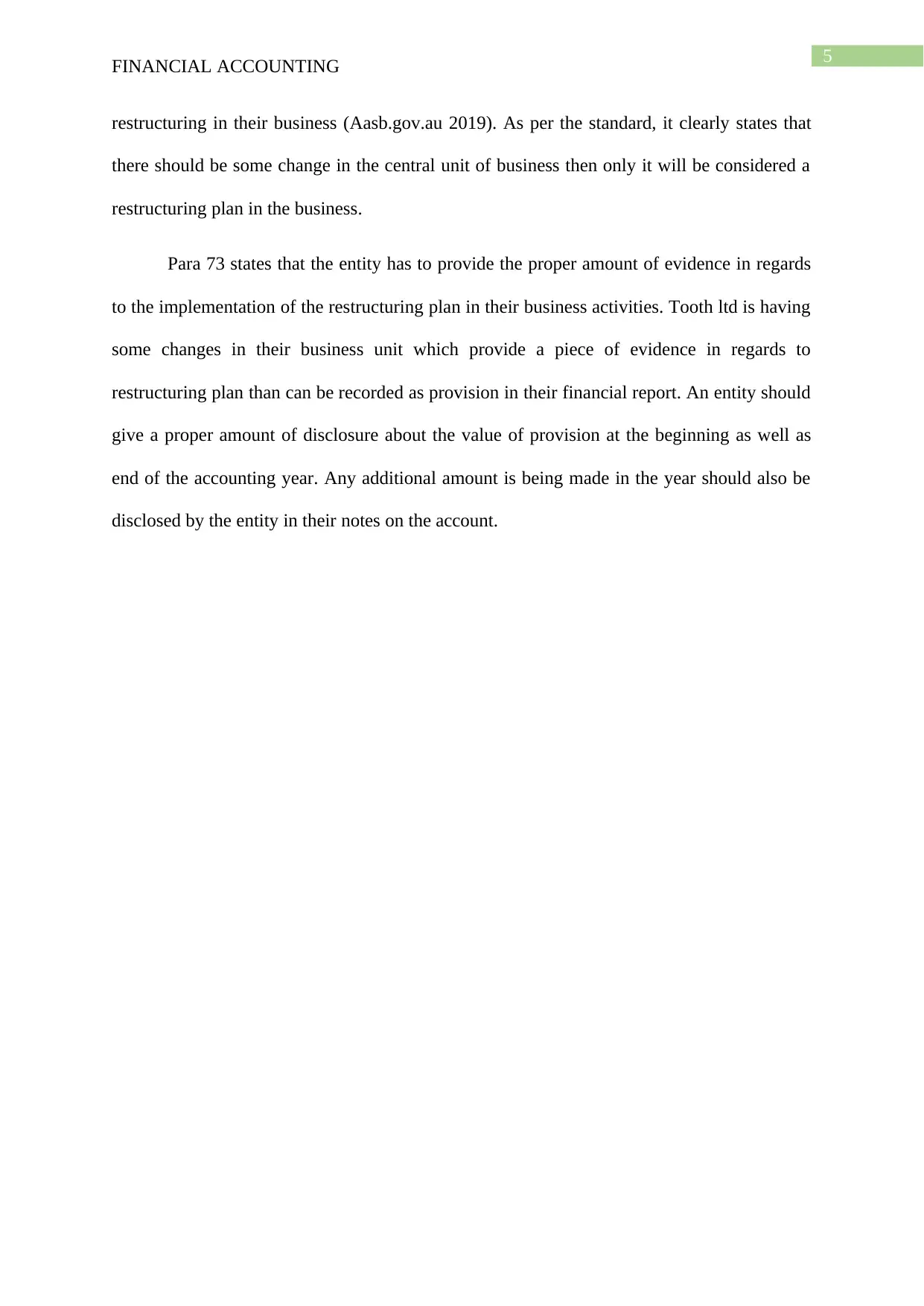
5
FINANCIAL ACCOUNTING
restructuring in their business (Aasb.gov.au 2019). As per the standard, it clearly states that
there should be some change in the central unit of business then only it will be considered a
restructuring plan in the business.
Para 73 states that the entity has to provide the proper amount of evidence in regards
to the implementation of the restructuring plan in their business activities. Tooth ltd is having
some changes in their business unit which provide a piece of evidence in regards to
restructuring plan than can be recorded as provision in their financial report. An entity should
give a proper amount of disclosure about the value of provision at the beginning as well as
end of the accounting year. Any additional amount is being made in the year should also be
disclosed by the entity in their notes on the account.
FINANCIAL ACCOUNTING
restructuring in their business (Aasb.gov.au 2019). As per the standard, it clearly states that
there should be some change in the central unit of business then only it will be considered a
restructuring plan in the business.
Para 73 states that the entity has to provide the proper amount of evidence in regards
to the implementation of the restructuring plan in their business activities. Tooth ltd is having
some changes in their business unit which provide a piece of evidence in regards to
restructuring plan than can be recorded as provision in their financial report. An entity should
give a proper amount of disclosure about the value of provision at the beginning as well as
end of the accounting year. Any additional amount is being made in the year should also be
disclosed by the entity in their notes on the account.
⊘ This is a preview!⊘
Do you want full access?
Subscribe today to unlock all pages.

Trusted by 1+ million students worldwide
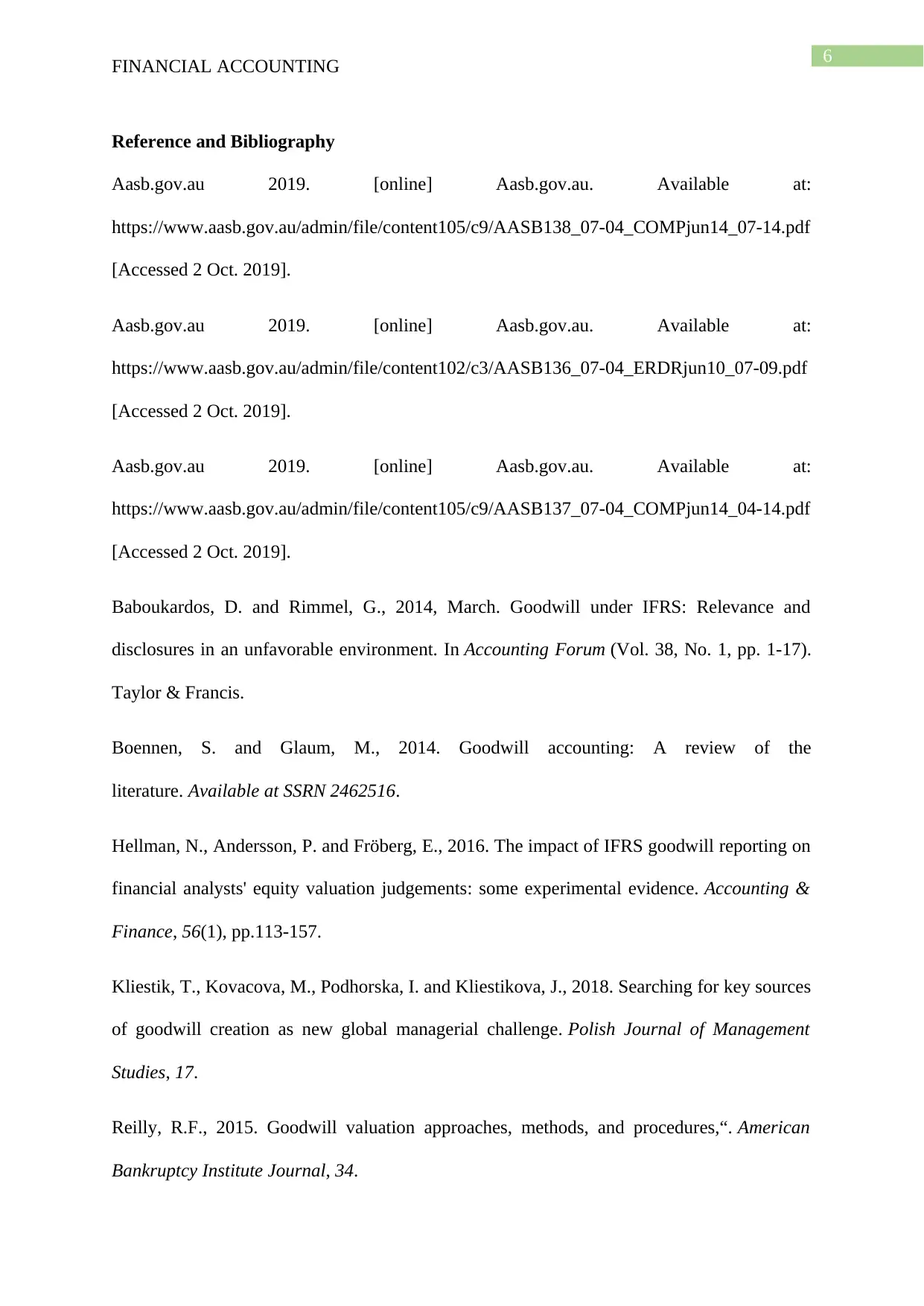
6
FINANCIAL ACCOUNTING
Reference and Bibliography
Aasb.gov.au 2019. [online] Aasb.gov.au. Available at:
https://www.aasb.gov.au/admin/file/content105/c9/AASB138_07-04_COMPjun14_07-14.pdf
[Accessed 2 Oct. 2019].
Aasb.gov.au 2019. [online] Aasb.gov.au. Available at:
https://www.aasb.gov.au/admin/file/content102/c3/AASB136_07-04_ERDRjun10_07-09.pdf
[Accessed 2 Oct. 2019].
Aasb.gov.au 2019. [online] Aasb.gov.au. Available at:
https://www.aasb.gov.au/admin/file/content105/c9/AASB137_07-04_COMPjun14_04-14.pdf
[Accessed 2 Oct. 2019].
Baboukardos, D. and Rimmel, G., 2014, March. Goodwill under IFRS: Relevance and
disclosures in an unfavorable environment. In Accounting Forum (Vol. 38, No. 1, pp. 1-17).
Taylor & Francis.
Boennen, S. and Glaum, M., 2014. Goodwill accounting: A review of the
literature. Available at SSRN 2462516.
Hellman, N., Andersson, P. and Fröberg, E., 2016. The impact of IFRS goodwill reporting on
financial analysts' equity valuation judgements: some experimental evidence. Accounting &
Finance, 56(1), pp.113-157.
Kliestik, T., Kovacova, M., Podhorska, I. and Kliestikova, J., 2018. Searching for key sources
of goodwill creation as new global managerial challenge. Polish Journal of Management
Studies, 17.
Reilly, R.F., 2015. Goodwill valuation approaches, methods, and procedures,“. American
Bankruptcy Institute Journal, 34.
FINANCIAL ACCOUNTING
Reference and Bibliography
Aasb.gov.au 2019. [online] Aasb.gov.au. Available at:
https://www.aasb.gov.au/admin/file/content105/c9/AASB138_07-04_COMPjun14_07-14.pdf
[Accessed 2 Oct. 2019].
Aasb.gov.au 2019. [online] Aasb.gov.au. Available at:
https://www.aasb.gov.au/admin/file/content102/c3/AASB136_07-04_ERDRjun10_07-09.pdf
[Accessed 2 Oct. 2019].
Aasb.gov.au 2019. [online] Aasb.gov.au. Available at:
https://www.aasb.gov.au/admin/file/content105/c9/AASB137_07-04_COMPjun14_04-14.pdf
[Accessed 2 Oct. 2019].
Baboukardos, D. and Rimmel, G., 2014, March. Goodwill under IFRS: Relevance and
disclosures in an unfavorable environment. In Accounting Forum (Vol. 38, No. 1, pp. 1-17).
Taylor & Francis.
Boennen, S. and Glaum, M., 2014. Goodwill accounting: A review of the
literature. Available at SSRN 2462516.
Hellman, N., Andersson, P. and Fröberg, E., 2016. The impact of IFRS goodwill reporting on
financial analysts' equity valuation judgements: some experimental evidence. Accounting &
Finance, 56(1), pp.113-157.
Kliestik, T., Kovacova, M., Podhorska, I. and Kliestikova, J., 2018. Searching for key sources
of goodwill creation as new global managerial challenge. Polish Journal of Management
Studies, 17.
Reilly, R.F., 2015. Goodwill valuation approaches, methods, and procedures,“. American
Bankruptcy Institute Journal, 34.
1 out of 7
Related Documents
Your All-in-One AI-Powered Toolkit for Academic Success.
+13062052269
info@desklib.com
Available 24*7 on WhatsApp / Email
![[object Object]](/_next/static/media/star-bottom.7253800d.svg)
Unlock your academic potential
Copyright © 2020–2025 A2Z Services. All Rights Reserved. Developed and managed by ZUCOL.




